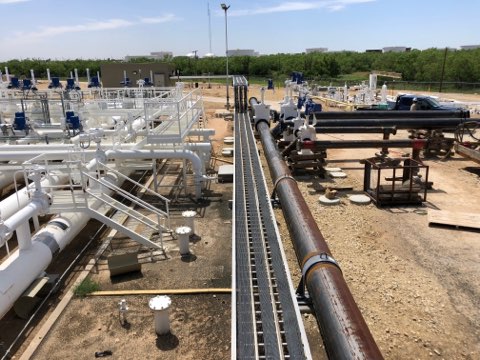Everything About Oil Field Equipment and Pipeline Equipment: Key Insights and Important Details
Oil field equipment and pipeline systems play a critical duty in the oil and gas industry. They are vital for the reliable removal and transportation of hydrocarbons. Secret elements, such as piercing rigs and storage space tanks, directly impact functional success. Innovations in modern technology promise to improve safety and security and performance. Comprehending these components is vital for anybody associated with or thinking about this complicated field, as it establishes the stage for much deeper expedition of industry practices.

Overview of Oil Field Equipment
As the need for oil proceeds to expand, understanding the tools utilized in oil areas becomes significantly crucial. Oil field equipment includes a vast array of machinery and devices essential for expedition, extraction, and handling. Key elements consist of drilling rigs, which are essential for reaching oil storage tanks, and production devices, such as separators and pumps, that promote the extraction procedure. Superior Oilfield Rentals oilfield. Furthermore, storage space containers play a considerable role in holding petroleum before transport. Safety and security devices, consisting of blowout preventers and stress gauges, ensures functional safety and security and efficiency. Each piece of devices features cohesively to maximize production and maintain efficient process. Familiarity with this tools is essential for professionals in the industry to guarantee successful procedures and adherence to safety standards
Kinds of Drilling Rigs and Their Applications
Drilling rigs function as the foundation of oil removal procedures, with different kinds made for specific geological problems and functional requirements. The most common types include rotating drilling rigs, which utilize a revolving drill little bit to penetrate the earth, and wire tool rigs, recognized for their percussion exploration method. For offshore procedures, jack-up rigs and semi-submersible rigs supply security and support in aquatic settings. Furthermore, directional boring rigs allow operators to drill at angles, getting to down payments that are not vertically easily accessible. Each rig kind has special advantages, optimizing effectiveness and safety based upon the boring setting. Selecting the proper gear is necessary for optimizing resource extraction while reducing ecological influence and operational prices.

Vital Pipeline Equipment and Their Functions
Pipeline framework is essential for the transport of oil and gas from extraction sites to refining facilities and end-users. Different necessary tools elements promote this process. Pipes themselves function as the key avenues, made to withstand high pressure and corrosive compounds. Pump stations are important for maintaining circulation by increasing stress along the pipeline. Shutoffs play an important function in controlling flow and separating areas for maintenance. In addition, installations and ports ensure secure joints between pipe sections. Checking systems, including circulation meters and stress sensing units, are crucial for identifying leakages and enhancing flow rates. Pigging tools is utilized for maintenance and cleaning, safeguarding pipeline honesty and performance. Together, these elements form the backbone of a trustworthy pipeline look at these guys system.
Developments and Technologies in Oil and Gas Equipment

Safety and Upkeep Practices in the Oil Market
While the oil sector has actually made significant strides in innovation and effectiveness, the importance of durable safety and upkeep methods can not be overemphasized. Effective safety procedures are important to secure workers and the environment, decreasing the threat of crashes and spills. Regular assessments and maintenance of devices assistance determine prospective concerns before they rise, ensuring operational integrity. Educating programs for workers are important, stressing the importance of safety recognition and emergency feedback treatments. Furthermore, adherence to sector guidelines and criteria promotes a culture of safety and security. Applying sophisticated monitoring innovations can further enhance maintenance techniques, permitting for real-time analyses of tools conditions. Ultimately, focusing on safety and security and upkeep is integral to the sustainability and success of browse around here the oil sector.
Frequently Asked Concerns
What Are the Environmental Impacts of Oil Field Equipment?
The ecological influences of oil field equipment include environment devastation, water contamination, and air contamination (Superior Oilfield Rentals). Additionally, devices breakdown can result in spills, adversely affecting wildlife and environments, highlighting the requirement for rigorous regulations and monitoring
How Is Oil Field Equipment Delivered to Remote Locations?
Transferring oil field equipment to remote locations frequently includes specialized lorries, helicopters, or barges. Logistics firms coordinate courses, guaranteeing equipment gets here safely and efficiently, thinking about surface and access to lessen hold-ups and make the most of productivity.
What Regulatory Specifications Govern Oil Field Equipment?
Regulatory requirements governing oil field equipment largely consist of security, environmental management, and operational effectiveness guidelines. Agencies such as OSHA and EPA apply these visit our website laws to guarantee safe methods and minimize eco-friendly effect in oil extraction operations.
What Abilities Are Required to Operate Oil Field Equipment?

How Do Oil Rates Affect Equipment Demand and Usage?
Oil prices substantially influence tools need and use. Higher prices normally lead to increased expedition and manufacturing activities, driving demand for equipment. On the other hand, lower rates might result in decreased operations and reduced need for equipment.